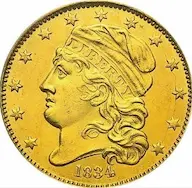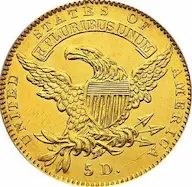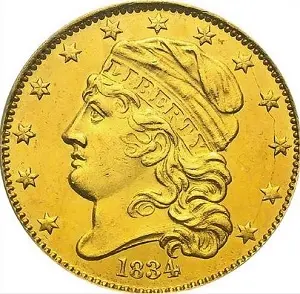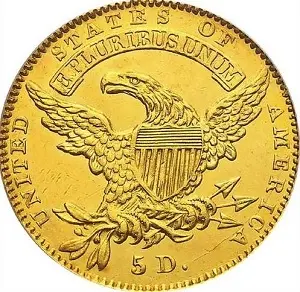1834 Capped Head $5 Dollar Half Eagle, Cross 4
The story of the 1834 Capped Head Cross 4 half eagle closely parallels that of 1834 Plain 4 half eagle.
The Capped Head $5 half eagle of 1813-34 suffered heavy losses from melting. This occurred for two reasons:
- Almost from the implementation of the Mint Act of 1792, gold was more highly valued in Europe than the United States. A U.S. $5 half eagle was worth $5.33 in Europe, promoting its melting and transfer across the Atlantic.(1)
- The Coinage Act of 1834 reduced the weight of gold in U.S. coinage. After August 1 of that year, anyone who deposited, say, $500 face value of gold coins received $533 in newly minted gold coins of the Classic Head type.
It has been estimated that over 99% of their original mintage perished in cauldrons, leaving numerous Capped Head half eagle dates as among the rarest coins in U.S. numismatics.(2)
The 1834 Capped Head half eagle did not escape this fiery fate. In fact, in expectation of the Coinage Act, Mint Director Samuel More ordered all the unreleased 1834 half eagles to be melted down. Of the 74,709 half eagles struck in 1834, nearly one-third never left the Mint, resulting in a net production of 50,141 pieces.
There are two major varieties of the 1834 Capped Head half eagle. The one charted on this page features a serif on the 4 in the date, and is known as the “Cross 4” variety (often called “Crosslet 4”). The other variety, without the serif, is identified as the “Plain 4”.
There are estimated to be a mere 45 examples of the 1834 Capped Head half eagle with the Cross 4.(3) On the infrequent occasions when one is up for sale, the numismatic community watches keenly.
Thanks to its remarkable rarity and interesting history, any collector fortunate enough to own one of these melting pot escapees most likely will be delighted watching prices go higher and higher over time.
| Estimated survivors in all grades: 45 ?
The survivor estimate from PCGS represents an average of one or more experts' opinions as to how many examples survive of a particular coin in all grades. Survival estimates include coins that are raw, certified by PCGS, and certified by other grading services. Learn more at PCGS. |
| PCGS Rarity Scale: 8.6 ?
The 'PCGS CoinFacts Rarity Scale' assesses the relative rarity of all U.S. coins, based on estimated surviving examples. The scale runs from 1.0 to 10.0. The higher the number, the rarer the coin.
Learn more at PCGS. |
| Search for the 1834 Capped Head $5 Dollar Half Eagle, Cross 4 on eBay** |
Preview of eBay selection (the Search link above may also find examples of this rarity):
 |
 |
| Trendline Avg = 16.94 | GOOD |
 |
 |
| Trendline Avg = 16.94 | GOOD |
Historic Value Trend Charts:
| Last updated 8-11-25 | Return to Key Date Coin List | |
| Compare to Common Date Coin of Same Type | ||
|
|
||
| Download Charts to Your Computer | ||
Sources
1. Stack's Bowers Galleries. 1834 Capped Head Left Half Eagle. BD-2. Crosslet 4. Dec 2020 Auction.
2. Heritage Auctions. 1834 $5 Capped Head, Plain 4. Aug 2011 Auction.
**Many very fine coin dealers sell on eBay. At any point in time, there may be over one million search results for United States coins. This includes quite a few of the recommendations on our Key Date Coin List.
If you’re thinking about purchasing a rare coin, eBay is certainly worth a look. For your convenience, the links from this site to eBay are coded to bring up only coins certified by PCGS and NGC.
As is always, always the case, never buy a valuable coin from a seller whose trustworthiness cannot be verified. Learn more about this at our chapter Best Places to Buy Coins, which also has a section on doing business on eBay.
In the interest of full disclosure, Rare Coins 101 receives a small commission anytime someone connects to eBay from this site and purchases something.
Coin images by Stack's Bowers Galleries.


